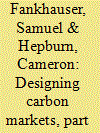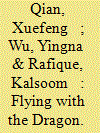| Srl | Item |
| 1 |
ID:
097338


|
|
|
|
|
| Publication |
2010.
|
| Summary/Abstract |
This paper analyses the design of carbon markets in space (i.e., geographically). It is part of a twin set of papers that, starting from first principles, ask what an optimal global carbon market would look like by around 2030. Our focus is on firm-level cap-and-trade systems, although much of what we say would also apply to government-level trading and carbon offset schemes. We examine the "first principles" of spatial design to maximise flexibility and to minimise costs, including key design issues in linking national and regional carbon markets together to create a global carbon market.
|
|
|
|
|
|
|
|
|
|
|
|
|
|
|
|
| 2 |
ID:
147896


|
|
|
|
|
| Summary/Abstract |
Gains under the global value chains (GVCs) depend on how much of a country’s domestic value added (DVA) is passing onto other countries. However, India’s manufacturing sector is found to be hollowing out, that is, its DVA growth is declining. This article estimates the linkages of manufacturing sector into GVCs, focusing on machinery and textiles industries. It measures foreign value added in exports and gains under GVCs using intercountry input–output tables of OECD–WTO Trade in Value Added (TiVA) database (2015). TiVA shows a decline in India’s share of DVA exports in its gross exports. However, India has ‘net gains’ from linking into GVCs in the two industries as the ratio of forward linkages to backward linkages is greater than one. This indicates that value-added exports are greater than value-added imports. Thus, India has enough potential to compete with other countries in the upper ends of value chains in both its machinery and textiles industries.
|
|
|
|
|
|
|
|
|
|
|
|
|
|
|
|
| 3 |
ID:
175571


|
|
|
|
|
| Summary/Abstract |
As a large trading nation, China competes with importing countries’ domestic and third‐country markets but also creates growth opportunities for exporters. Most studies on China trade shocks or “China shocks” focuse on the impacts of import competition on developed economies. The present paper complements research on China shocks by exploring the other side of the trade exposure to China – China as the largest importer, rather than as an exporter. We analyze the effects of export expansion into China on the local labor markets of the exporting developing countries for the years 1992 to 2018. Using detailed export and employment data, we estimate employment pattern variations in manufacturing industries with exports from other developing countries as instruments for export exposure. We find that the increase in trade exposure to China in the world economy has caused extensive job gains in manufacturing industries in developing countries that were exporters. On average, our estimations show that this trade exposure created approximately 1.5 million additional jobs from 1992 to 2018, which made an important contribution to manufacturing industries in developing countries. Our empirical analysis also shows that trade had stabilizing effects on employment in the countries in our sample generally.
|
|
|
|
|
|
|
|
|
|
|
|
|
|
|
|